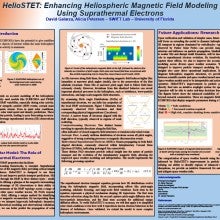HelioSTET: Modeling Suprathermal Electron Transport through the Heliospheric Magnetic Field
David
Galarza
University of Florida
Poster
A major limitation in current space weather forecasting lies in the lack accuracy in modeling the heliospheric magnetic field (HMF), which significantly impacts the prediction of solar energetic particles (SEPs), coronal mass ejections (CMEs), and other transient solar phenomena. These inaccuracies have direct implications for spacecraft operations, satellite communications, GPS navigation, and other critical infrastructure. Suprathermal electrons (SEs), due to their ability to travel along HMF lines, serve as valuable tracers of the magnetic field’s properties and dynamics. Their pitch angle distributions (PADs) encode essential information about the HMF and the surrounding plasma, yet the mechanisms connecting observed PADs to specific HMF features remain poorly understood. This research focuses on addressing this challenge by developing the Heliospheric Suprathermal Electron Transport (HelioSTET) model, a novel framework that leverages SE observations to identify and characterize key HMF features. By linking SE PADs to variations in the HMF, this work aims to provide new tools for tracing transient solar events to their origins and enhancing the understanding of solar wind dynamics.

Poster PDF
Poster category
Solar and Interplanetary Research and Applications
Meeting homepage